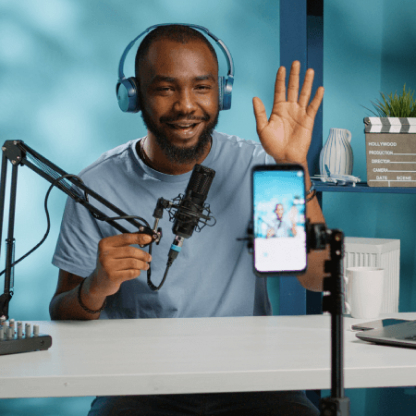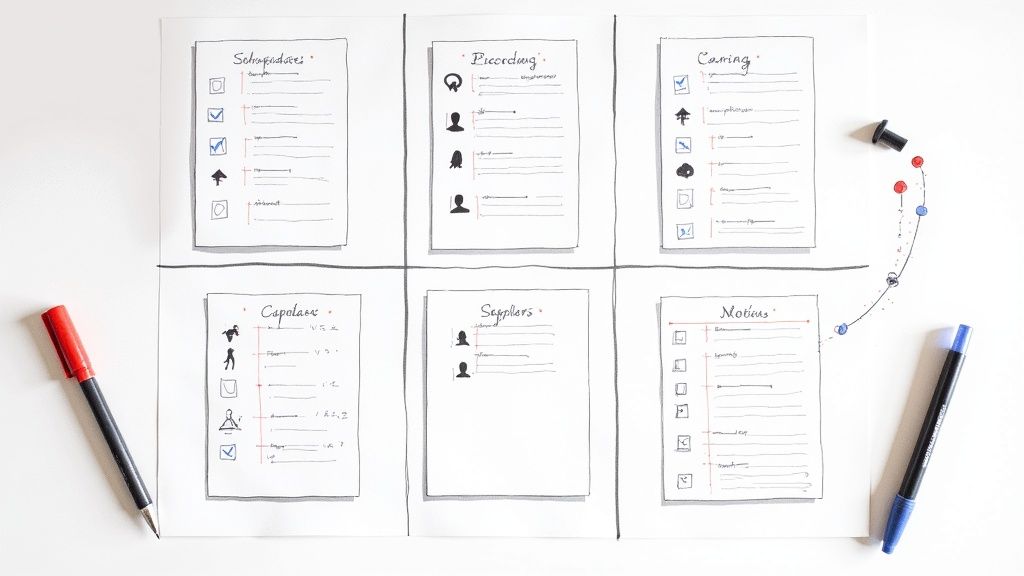Let's be honest. Your hiring process is probably a mess. It’s a jumble of inconsistent questions, frantic notes scribbled on a resume, and a vague "gut feeling" that’s impossible to explain later. You wrap a day of interviews with a general sense of who you "liked," but you have zero real data to back it up.
Sound familiar? Of course it does. We’ve all been there.
It’s the classic standoff: one interviewer is charmed by a candidate's charisma, while another sees nothing but red flags. What follows is a debrief that feels more like a debate club than a strategic decision. In the end, you either lose a great candidate to the chaos or, far worse, you hire the wrong person. An interview rating sheet is your way out of this mess.
Your Hiring Process Is Probably Broken
The $500 Hello
Hiring mistakes aren't just inconvenient; they're brutally expensive. The cost of a bad hire is staggering, often reaching 30% of that employee's first-year salary. Just think about it—the wasted training, the lost productivity, the morale nosediving across the team. Suddenly, that charming-but-unqualified candidate becomes a multi-thousand-dollar liability.
This isn't some minor HR issue; it’s a critical business leak. And the data shows it's a problem almost everyone is facing.
A 2022 study from Aptitude Research revealed that a shocking one in three companies aren't confident in their own interview processes. To make it worse, half of them admitted to losing great talent because of it. You can dig into the specifics in the full report on interviewing effectiveness.
When your process is a free-for-all, you're not just risking a bad hire—you're actively pushing top talent right out the door.
From Chaos to Clarity
An unstructured interview is a complete gamble. Every conversation wanders, making it impossible to compare candidates on an even playing field. This is where an interview rating sheet becomes your most valuable weapon. It’s not about adding more bureaucracy; it’s about injecting some much-needed discipline.
By defining what "good" actually looks like before the first interview, you force your team to focus on what truly matters. This simple document helps you:
- Standardize Evaluation: Ensure every candidate is measured against the exact same stick. No more comparing apples to oranges.
- Reduce Unconscious Bias: Force interviewers to justify their ratings with concrete evidence, not just fuzzy feelings or first impressions.
- Improve Collaboration: Give your team a common language and a clear framework for their discussions, leading to faster, smarter decisions.
The difference is night and day. One is based on whims, the other on deliberate, strategic evaluation.
Unstructured vs Structured Interviews The Real Difference
| Factor | The 'Gut Feeling' Method | The Structured Rating Sheet Method |
|---|---|---|
| Consistency | All over the place. Each interviewer asks different questions, focusing on what they personally value. | Standardized. Every candidate gets the same core questions, allowing for a true side-by-side comparison. |
| Objectivity | Low. Prone to "similar-to-me" bias, halo/horn effects, and focusing on charisma over competence. | High. Decisions are based on pre-defined criteria and evidence, not just how much you "liked" the person. |
| Decision Making | Messy and subjective. Debriefs often turn into arguments based on personal impressions. | Data-driven and collaborative. The team discusses scores and evidence, leading to a confident, defensible choice. |
| Legal Risk | High. Lack of a consistent process makes it difficult to defend hiring decisions if challenged. | Low. The structured process provides clear documentation and shows a fair, equitable evaluation for all candidates. |
| Candidate Experience | Inconsistent and often confusing. Candidates can feel like they're on an uneven playing field. | Fair and professional. Candidates appreciate a thoughtful process that focuses on job-relevant skills. |
Ultimately, a structured approach protects you from your own biases and ensures you're making a sound business decision, not just hiring your new best friend.
The chart below breaks down the typical criteria you'll find on a rating sheet that doesn't suck.
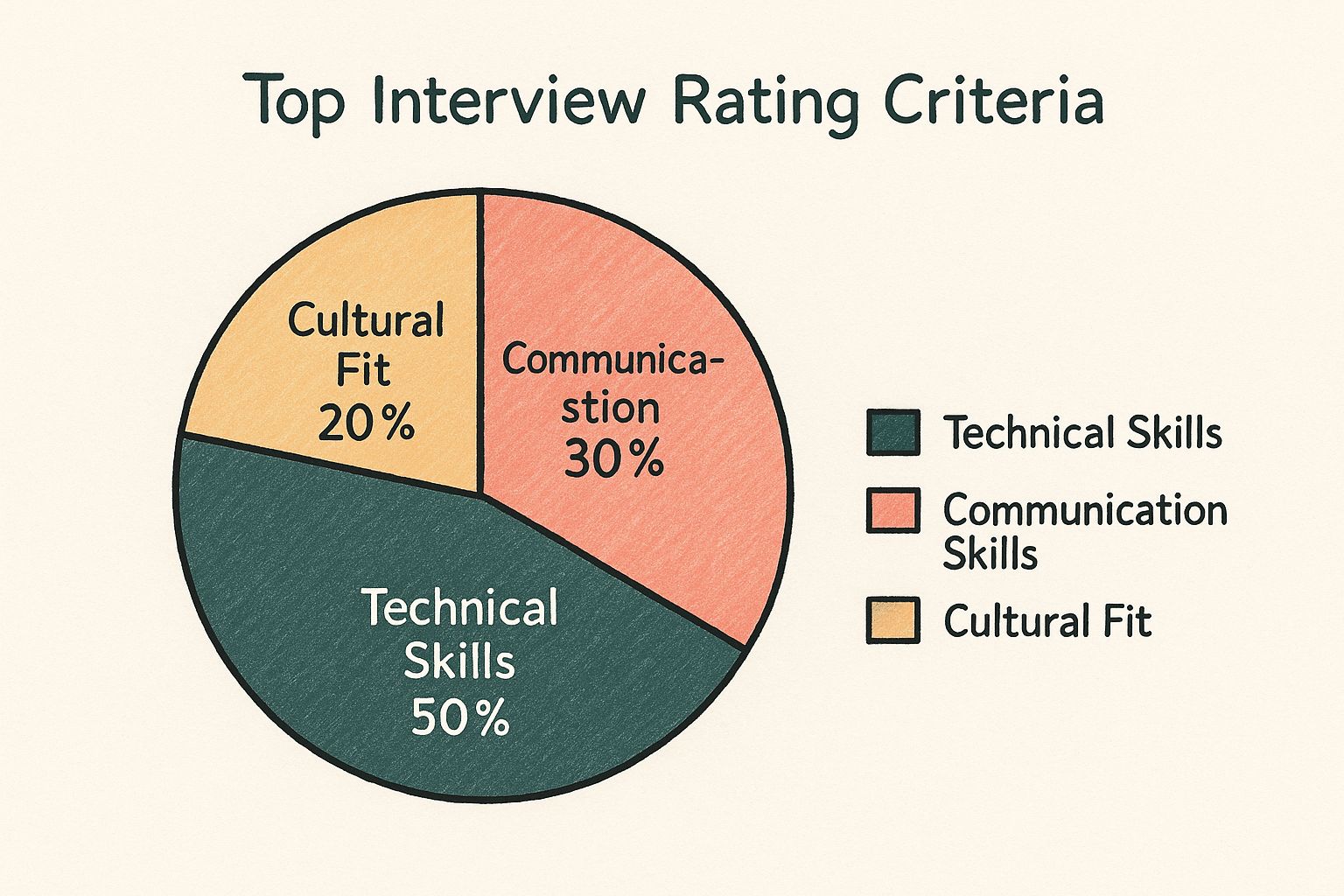
As you can see, technical skills are the price of entry, but it's the mix of strong communication and cultural alignment that turns a skilled person into a key player. A well-designed rating sheet helps you balance these priorities, stop the bleeding, and finally bring clarity to your most important business decision.
Designing a Scorecard That Actually Works
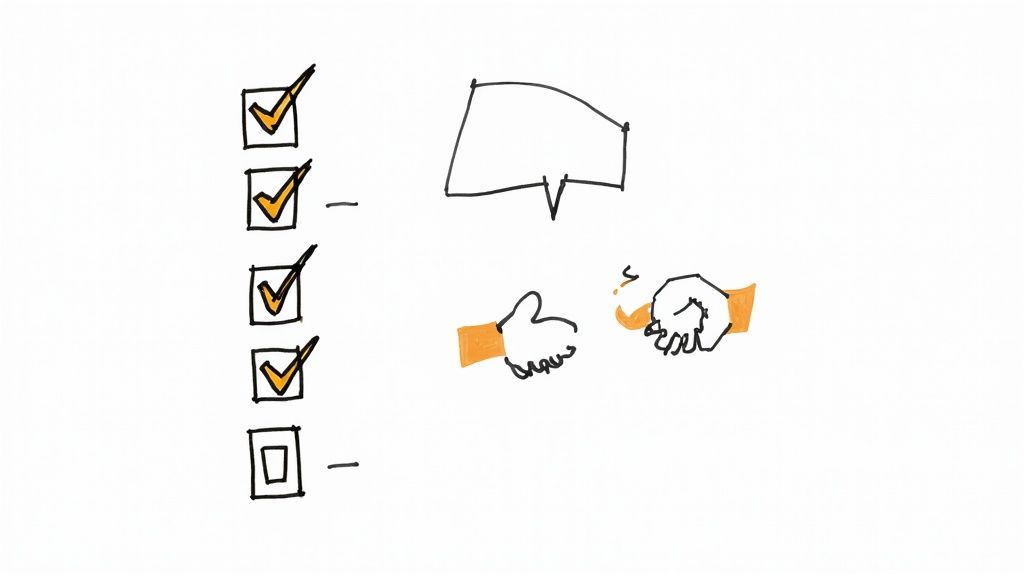
Here's where most teams drop the ball. They grab a generic template, slap their logo on it, and wonder why it feels like they’re trying to fit a square peg in a round hole. A truly effective scorecard isn’t a checklist; it's a strategic weapon you forge for the specific role you’re filling.
It forces you and your team to get in a room and define what "good" actually looks like before a single candidate even applies. This isn't just about listing skills. It's about codifying success.
Start With The Dealbreakers
Before you even think about questions, lock down your non-negotiables. These are the absolute pillars of the role—the things that, if missing, make everything else irrelevant. Forget the nice-to-haves for a second and get brutally honest.
I find it helps to break this down into three core buckets:
- Core Competencies: These are the foundational abilities someone needs to just do the job. Think "Analytical Thinking" for a data scientist or "Client Relationship Management" for an account exec. Be specific. "Good Communicator" is lazy; "Clearly Articulates Complex Technical Concepts to Non-Technical Stakeholders" is a real, measurable competency.
- Technical Skills: This one's usually the easy part. What software, languages, or specific technical knowledge is required from day one? List the must-haves, not the "we can teach them that" skills.
- Values Alignment: This isn't about hiring people you'd want to grab a beer with. It’s about pinning down the core behaviors that make people successful on your team. Do you value radical ownership? Scrappy problem-solving? A deep-seated customer obsession? Nail these down.
Get these three categories right, and you’ve built the foundation for an interview rating sheet that separates the truly great candidates from the ones who just look good on paper.
The Problem With a Simple 1 to 5 Scale
Okay, let's talk scoring. Most templates push a simple 1-5 scale. The problem? Not all criteria are created equal. Is "Proficiency in Python" really as important as "Cultural Fit"? Maybe. Maybe not.
This is why you need a weighted scoring system. It’s a simple concept that forces you to prioritize what actually matters for success in the role.
Your scorecard isn't just about rating answers; it's about rating them in proportion to their impact. A weighted system ensures a candidate who aces your most critical criteria gets the credit they deserve, even if they fumble a less important question.
Here's a painfully simple way to do it. Just assign a multiplier to each of your core buckets. For a senior engineering role, it might look like this:
- Technical Skills: Multiplier of 3x (Absolutely critical)
- Core Competencies (Problem-Solving, etc.): Multiplier of 2x (Very important)
- Values Alignment: Multiplier of 1x (Important, but can be developed)
Now, a candidate who scores a '4' on a technical skill gets 12 points, while that same '4' on values alignment only gets 4. Suddenly, your final score is a much more accurate reflection of their potential. It’s a small tweak that makes a world of difference. For a deeper look, our guide on the essential interview evaluation sheet has more examples.
From Criteria to Killer Questions
Once you have weighted criteria, the final piece is crafting questions that map directly to each one. This is how you make every minute of the interview count. No more generic fluff like, "So, what's your biggest weakness?"
Instead, you build a direct bridge from your needs to your questions.
-
Instead of: Asking about "Teamwork."
-
You ask: "Tell me about a time you had a significant disagreement with a colleague. How did you handle it, and what was the outcome?" This is a behavioral question that forces them to provide evidence, not just a canned answer.
-
Instead of: Asking if they're a "Problem-Solver."
-
You ask: "Walk me through the most complex technical problem you've solved in the last year. What was your process from identifying the issue to implementing the solution?"
Every question should be a surgical tool, designed to extract proof related to a specific, high-value criterion on your scorecard. This is the difference between having a chat and conducting an evaluation. One feels nice; the other gets you the right hire.
Scoring Candidates Without The Bias
You did the hard work. You hammered out the details, defined your non-negotiables, and built a slick, weighted interview rating sheet. High five. Now for the part where most good intentions go to die.
Using the sheet consistently is the real challenge. It's tough when you meet a candidate you instantly click with. You know the feeling. They love the same obscure sci-fi author, and suddenly your brain is flooded with confirmation bias, ready to give them a '5' across the board. The opposite is just as dangerous; a candidate who reminds you of your annoying cousin starts at an immediate, unfair disadvantage.
This is why interviewer calibration isn't a "nice-to-have." It’s everything.
What Does a '4' Even Mean Anyway?
The biggest weakness in any rating system is human interpretation. To one interviewer, a ‘4’ in "Problem Solving" means the candidate offered a solid, logical answer. To another, it means they solved it faster than anyone they’ve ever seen. Without a shared language, your data is garbage.
You have to get everyone in a room and agree on what a ‘1’, a ‘3’, and a ‘5’ actually look like in practice. This isn't some philosophical debate; it's a practical necessity.
Run a mock interview. Have one person play the candidate, give a pre-scripted answer, and get everyone to score it independently. Compare the scores. You'll probably be shocked at the variance. This is where you hash it out and build a concrete rubric everyone can stand behind.
A Scoring Rubric That Actually Helps
Don't just define the numbers with vague terms like "Exceeds Expectations." That helps no one. You need concrete, behavioral examples for each level.
Here’s a quick example for the competency "Takes Ownership":
- Score 1 (Insufficient): Blames past employers or colleagues for failures ("My last boss was a micromanager…"). Uses "we" for wins and "they" for setbacks.
- Score 3 (Meets Expectations): Clearly describes their specific role in a project's success. Acknowledges a past failure and can explain what they learned, but the lesson feels a bit generic.
- Score 5 (Excellent): Proactively brings up a significant failure without being prompted. Not only explains what they learned but details the specific process changes they implemented to prevent it from happening again. Their language is all "I did this," "I was responsible for," "I fixed it."
See the difference? Now your team isn't just scoring based on gut feelings—they're pattern-matching against an agreed-upon standard.
Your interview rating sheet is your objective shield against your brain’s laziest shortcuts. It's the tool that forces you to swap "I have a good feeling about them" for "Here is the evidence that they meet our criteria."
This critical shift from feeling to evidence is how you build a team of elite performers, not just a team of people you’d like.
Fighting Your Brain's Worst Instincts
Even with a killer rubric, biases are sneaky. They creep in when you’re tired, distracted, or just being human. The rating sheet is your defense, but you have to actively use it to fight these common culprits:
- The Halo Effect: This is the big one. A candidate has one stellar quality—maybe they’re an incredible coder—and you let that positive glow blind you to their weaknesses in other critical areas.
- Confirmation Bias: You form an impression in the first two minutes and spend the rest of the interview subconsciously hunting for evidence to prove your initial gut feeling right.
- "Similar-to-Me" Bias: We all naturally gravitate toward people who share our background or hobbies. It feels comfortable, but it leads to a homogenous team starved of diverse perspectives.
The scorecard forces you to pause. It demands a specific example for that "Communication Skills" score. When you can’t find one, it’s a red flag that bias might be driving your decision. To get an even more objective read, some teams are now incorporating personality tests for business leaders to gain a wider perspective.
Scoring isn't about removing the human element. It’s about strengthening it with a framework that ensures your decisions are rooted in evidence, not just emotion. That’s how you hire the best person for the job, not just the person who made the best first impression.
Adapting Your Rating Sheet For Remote Interviews

Let's be real, the hiring world has changed for good. Remote interviews are a different beast, and if your interview rating sheet hasn't evolved, you're making decisions based on faulty signals.
Over video, you lose all the subtle body language cues. A weird camera angle or an internet lag can make a confident candidate seem disengaged. A tech glitch can derail the conversation, and suddenly you’re judging their Wi-Fi instead of their qualifications.
Hope you enjoy being an unpaid IT support specialist, because that's now part of your job as an interviewer.
The Wi-Fi Is Not a Skill
This shift isn't just a trend; it's the new, messy standard. Research shows that a staggering 86% of businesses now use virtual interviews. At the same time, 33% of candidates reported facing technical issues. You can explore more of these job interview statistics to see how common these hiccups are.
A third of your interviews could be skewed by factors that have zero bearing on a candidate's ability to do the job. Your rating sheet needs to be a tool for fairness, not a casualty of a bad internet connection.
It’s time to adapt. This means adding new criteria to assess for remote-work readiness while training your team to see past the screen.
New Rules for a New Game
Your old scorecard needs a few new line items. Remote work demands a specific set of skills, and you need to explicitly measure them.
Here’s what to add to your rating sheet for remote interviews:
- Written Communication Clarity: So much work now happens over Slack and email. How clear and concise is their writing? Assess their application materials and any written follow-ups with a critical eye.
- Asynchronous Work Habits: You need behavioral questions about how they handle projects with colleagues in different time zones. You're looking for evidence of proactive updates and an ability to move work forward without constant meetings. Our guide on mastering asynchronous interviews digs deeper into this crucial skill.
- Tech Self-Sufficiency: How did they handle the call setup? Did they troubleshoot their own minor audio issue, or did they just give up and wait for you to fix it? This isn't about having a perfect setup; it’s about demonstrating basic problem-solving when faced with a tech hiccup.
These criteria aren't about penalizing someone for a bad connection. They're about actively looking for the skills that lead to success in a distributed team.
Train Your Interviewers to See Past the Screen
Adding new criteria is only half the battle. You have to actively train your interviewers to discount the irrelevant noise that comes with video calls.
The goal is to evaluate the candidate, not their camera quality. You need to explicitly tell your team to forgive awkward pauses from lag, poor lighting, or the occasional family member walking by in the background.
During your calibration sessions, make this a key point. Remind everyone that you're looking for the quality of their answers, not the quality of their broadcast. A great answer delivered through a choppy connection is still a great answer.
Your interview rating sheet is your best defense against "Zoom fatigue" bias. It forces you to anchor your evaluation in substance, ensuring you hire someone who can do the job—not just someone who has the best home office.
Supercharging Your Scorecard With AI
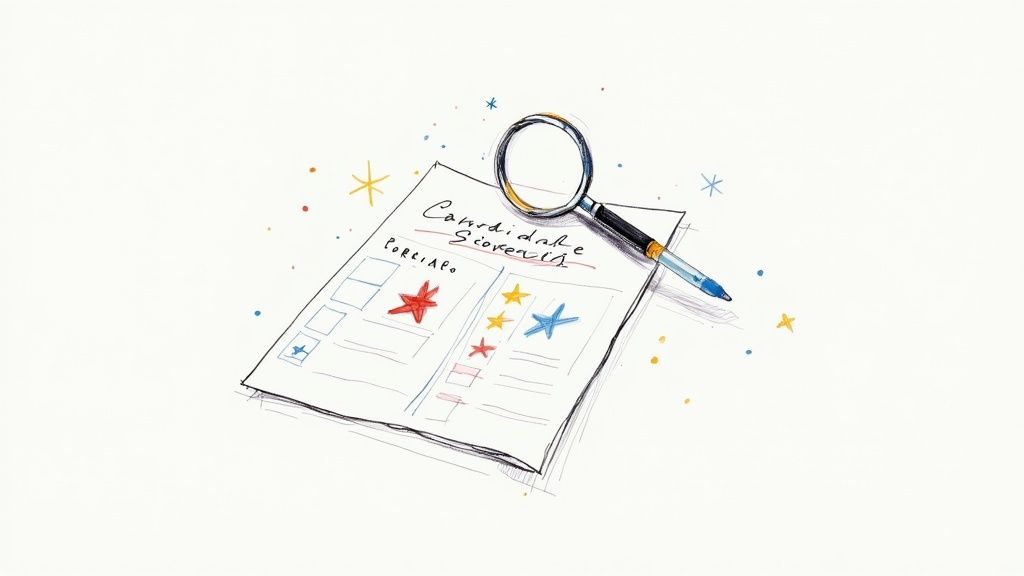
Alright, let's talk about the future, which is already here. Manually transcribing interviews, trying to fill out every box on your rating sheet, and then piecing together feedback from three different people is a soul-crushing time sink. It’s the kind of admin work that makes you wonder if you’re a recruiter or a professional paper-pusher.
This is where AI gives you superpowers. Seriously.
Imagine your video interviews being transcribed in real-time, with key moments automatically flagged—like every time a candidate mentions a critical skill. That’s not science fiction anymore. This is about making your process smarter, not replacing your hard-earned judgment. For a deeper dive into the mechanics, check out our complete guide to the interview score card.
AI as Your Co-Pilot, Not Your Replacement
The goal here isn't to let a robot make your hiring decisions. Never. It’s about using AI to gather better, more consistent data so you can make a more informed choice. Think of it as your co-pilot, handling the tedious stuff so you can focus on the subtle signals that truly matter.
AI can analyze candidate responses for key indicators tied to your core competencies, delivering insights you might miss while juggling note-taking and listening. It’s an incredible tool for spotting patterns across multiple interviews that would otherwise get lost in a sea of handwritten scribbles.
Of course, the hype around AI in HR is deafening. A recent survey found that while 25% of companies use AI to manage their interview process, a lot of candidates still crave that human connection. It's a delicate balancing act.
The secret is to use AI behind the scenes to sharpen your evaluation, not to create a robotic, impersonal experience. They still want to talk to a human, not a chatbot.
Using AI to augment your interview rating sheet is a powerful move, but it’s just one piece of the puzzle. An AI can’t tell you if a candidate will be a great cultural fit, but it can give you a perfectly transcribed answer to analyze for clues.
Where AI Can Help (And Where It Cannot)
Let's get practical. AI isn’t magic, and it’s terrible at some things. Knowing where to apply it is the difference between gaining an advantage and buying into expensive hype. Here’s a quick breakdown of where I’ve seen it work wonders—and where it falls flat.
| Task | Good Use of AI | Keep it Human |
|---|---|---|
| Initial Screening | Automatically transcribing and summarizing asynchronous video interviews to quickly screen for core keywords and skills. | Making the final call on who moves forward. AI flags data; you interpret it. |
| Note-Taking | Generating a complete, searchable transcript of the conversation. No more deciphering your own terrible handwriting. | Assessing non-verbal cues, enthusiasm, and genuine interest. AI can’t read the room. |
| Feedback Collation | Pulling all interviewer notes and scores into one centralized dashboard for easy comparison. | Hosting the debrief session. Your team needs to discuss the nuances and hash out disagreements. |
| Bias Reduction | Flagging potentially biased language in written feedback to help interviewers be more objective. | Evaluating a candidate's values, motivation, and long-term potential. This requires intuition. |
Ultimately, AI is a force multiplier for your interview rating sheet. It handles the data collection, freeing up your team to do what they do best: connect with people and make smart, strategic hiring decisions. To really level up, it's worth exploring how AI agents specifically designed for HR can enhance your workflow.
Frequently Asked Questions
Alright, let's get into the weeds. You've built the sheet, you've started using it, and now the real-world questions are popping up. Here are the direct, no-fluff answers to the questions I hear most often from founders trying to get this right.
How Do I Get My Team to Actually Use This Thing?
This is the big one. You can design the most beautiful interview rating sheet in the world, but if it sits in a folder, it’s useless. Getting buy-in isn't about sending a stern email; it's about showing them what’s in it for them.
First, frame it as a tool to end pointless debates. Nobody enjoys those circular debrief meetings. The rating sheet gives the whole team a common language. It turns "I just didn't get a good vibe" into a productive discussion about a low score in "Problem Solving" backed by a specific example.
Second, make it ridiculously easy to use. If it feels like homework, they won't do it. Integrate it into your workflow—a shared spreadsheet, a Slack channel for feedback, or a platform that automates it. The less friction, the better.
Do I Really Need a Different Rating Sheet for Every Single Role?
Short answer: Yes and no. You don't need to reinvent the wheel every time, but a one-size-fits-all approach is just lazy. Your core values and some soft skills—like "Communication"—will probably be consistent. Create a master template with these.
From there, customize the "Core Competencies" and "Technical Skills" sections for each role. It should take you 15 minutes, not five hours. A rating sheet for a Sales Rep should heavily weight "Resilience," while one for a Backend Engineer needs to prioritize "System Design."
Using the same generic sheet for a marketer and a developer is like using a hammer to fix a leaky faucet. It’s the wrong tool for the job, and you’re going to make a mess.
What if My Interviewers' Scores Are Wildly Different?
This isn't a problem; it's a signal. When one interviewer gives a candidate a '5' on "Strategic Thinking" and another gives a '2', it’s a massive red flag that your team isn't calibrated. Don't just average the scores and call it a day.
This is your cue to dig in. Ask each interviewer to defend their score with evidence. "What did you hear that made you score them a 5?" The person who gave the '2' will have to do the same. This conversation is where the magic happens. You’ll quickly discover that either one person missed something crucial, or, more likely, you all have different definitions of what "Strategic Thinking" even means.
These disagreements are your best opportunities to refine your scoring rubric and get everyone on the same page.
Should We Share the Interview Rating Sheet with Candidates?
Absolutely not. Transparency is great, but this is one of those times where it does more harm than good. The rating sheet is your internal decision-making tool, filled with candid (and sometimes blunt) assessments. Sharing it would just create anxiety for the candidate and make your interviewers less likely to be honest.
What you should be transparent about is your process. Let candidates know what to expect: "You'll be meeting with three team members, and we'll be focusing on your technical skills, problem-solving abilities, and how you approach teamwork." This sets clear expectations without handing over your playbook. It shows you have a structured, fair process, which is all a great candidate really wants.
Ready to stop the guesswork and build a hiring process that actually works? Async Interview automates the tedious parts of screening so you can focus on making confident, data-driven decisions. Ditch the spreadsheets and see how our AI-powered transcription and evaluation tools can supercharge your interview rating sheet. Start your free trial today.
